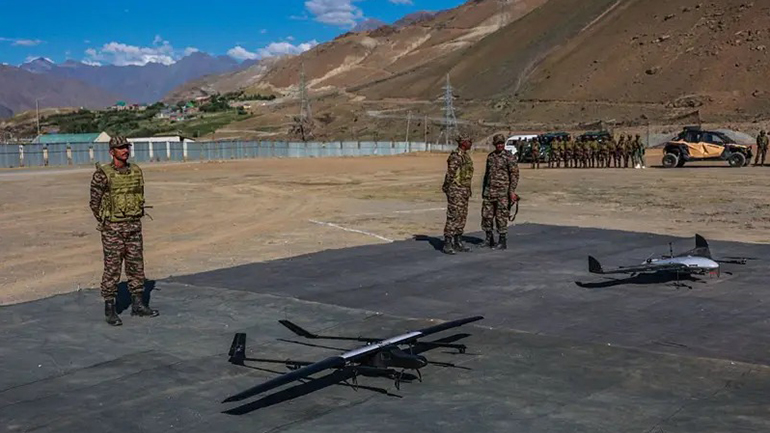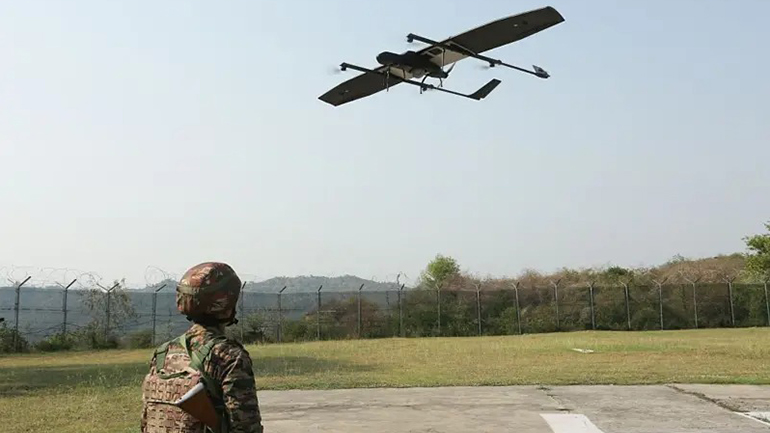

In May this year, following India-Pakistan military tensions, the Indian Army decided to establish dedicated “drone battalions” for its various branches as part of its future warfare strategy. Under this plan, one drone unit will be formed in each of the Army’s artillery, infantry, and armored divisions. These new units will be tasked solely with operating drones. According to officials, specialized military personnel will receive advanced training in various drone operations to fulfill this mission. On July 26, during Kargil Vijay Diwas, Indian Army Chief Upendra Dwivedi announced the creation of 30 Light Commando Battalions and Rudra Brigades, equipped with drones as well as all modern weapons and military gear.
The strategy to create drone battalions is part of the Indian Army’s broader modernization plan and its effort to integrate all three branches of the military. Indian defense analyst Rahul Bedi says discussions on the formation of drone battalions had already been underway. “After Operation Sandoor, incorporating drones into the army as combat units has become an essential part of a wider military strategy. In the past decade, wars such as the ongoing Ukraine-Russia war, the Azerbaijan conflict, and the Israel-Lebanon-Iran clashes have all seen large-scale and highly effective use of drones,” he explained. “One of the key advantages of drones is that they are generally inexpensive and can be used to destroy extremely advanced tanks worth billions of rupees. This makes them a cost-effective and highly effective weapon,” Bedi noted. According to him, the Indian Army is now building dedicated drone brigades consisting of 25 to 100 soldiers and technical experts, whose sole responsibility will be the operation of drones. “There will be two types of drones — attack drones and surveillance drones. The surveillance drones will identify targets and send signals to the attack drones, which will then strike the target either individually or with the help of 20–25 drones,” he added.
Drones are generally of three types. The first are short-range drones, capable of operating within 20 to 50 kilometers. The second category includes medium-altitude and high-altitude drones, and the third consists of extended-range drones. Some are highly advanced attack drones, such as the MQ-9B. India has purchased 31 drones of this design from the United States in a US-India defense deal worth $3.5 billion. India began drone procurement in the late 1990s. It has acquired Israeli-made Harpy, Heron, and Harop drones, which were also used extensively during Operation Sandoor. In addition to imports, India is also engaged in the production of indigenous drones. Drones are now being used in mountainous regions such as Ladakh and Arunachal Pradesh to deliver military supplies and logistics to soldiers positioned at high altitudes, supporting high-altitude warfare operations.

Three countries have made significant advancements in drone technology. Israel was the first to develop highly advanced drones, followed by the United States, which further enhanced the technology. Now, China is rapidly progressing in this field. Turkey and Iran have also made rapid strides in drone development. During the May clash between India and Pakistan, Pakistan deployed Chinese drones and Turkish drones. The era of high-tech drone warfare is steadily expanding. Defense analyst Rahul Bedi, “In the past, wars were fought by infantry, with gunfire exchanges—what was known as contact warfare. That is now disappearing. The task has been handed over to machines, and now we even have computer-controlled unmanned aerial vehicles (UAVs) being built.” “A human pilot can make targeting errors, but the chances of mistakes with these machines are almost negligible,” he added. According to Bedi, “In future warfare, the need for human soldiers will decrease while the reliance on machines will increase. Victory will belong to those who adopt and control the most advanced military technology.”

Defense analyst and editor of the military affairs journal Force, Pravin Sawhney, says that the Indian Army’s new drone battalion will not provide a significant advantage. According to him, until India develops an effective surveillance satellite system capable of monitoring the ground 24/7, these drones cannot be fully effective. “We saw during Operation Sandor that Pakistan had access to round-the-clock surveillance through China’s satellite network. This meant that Pakistan could track every movement of the Indian Army in real time, knowing exactly what was where,” he explained. Sawhney added, “The real value of drones comes when you have accurate battlefield intelligence in situations where neither side knows what lies ahead. Currently, both countries rely heavily on missile warfare, which has a long-range reach everywhere.” He emphasized, “Without 24/7 visibility, these units hold little strategic value. I’m not saying they’re unnecessary, but under present circumstances, they shouldn’t be the top priority.” In his view, the Indian Army’s first priority should be to acquire the capability for constant battlefield surveillance via satellites—a capability that Pakistan already enjoys through China. “We also need strong electronic warfare capabilities, which Pakistan currently possesses.” “At the moment, the Indian Army uses UAVs to monitor cross-border movements. The most important requirement for India now is military integration, meaning full coordination between the three armed forces branches. Current modernization efforts are not integrated. Discussions about establishing an Integrated Theatre Command have been ongoing since 2020, but there has been no concrete progress so far,” he noted.
Powered by Froala Editor